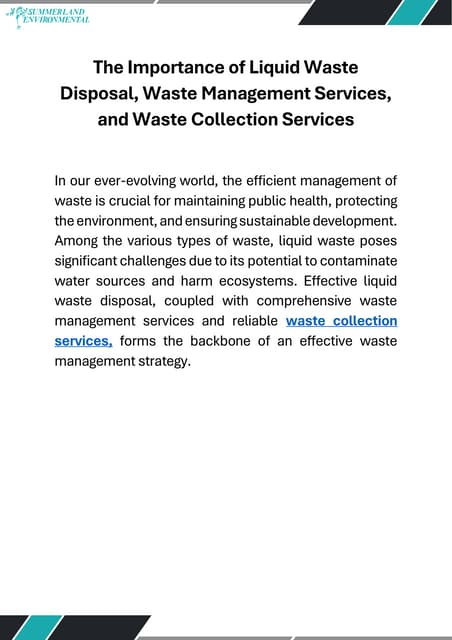Reclaim Waste Fundamentals Explained
Reclaim Waste for Beginners
Table of ContentsThe Buzz on Reclaim WasteGet This Report about Reclaim WasteThe 20-Second Trick For Reclaim WasteGet This Report about Reclaim WasteThe Facts About Reclaim Waste Revealed
Residential sewage waste refers to the waste and products from a residential septic container. The proper management and disposal of residential sewage waste require fluid waste to be transferred to a sewage therapy plant where the appropriate methods and devices are applied to purify and dispose of waste.
Industrial waste usually consists of potential hazards, such as combustible products or a blend of fluid and strong waste products, and needs a more advanced and detailed disposal process. The disposal of industrial waste typically includes the filtering of waste before transportation to ensure risk-free and appropriate disposal. Industrial waste is produced from byproducts and overflow of commercial processes and production.
This type of waste can not make use of the same sewage administration transportation or processes as septic or business fluids. The hazardous waste administration process requires the inspection and testing of fluid waste prior to it goes through the disposal procedure (liquid waste disposal). Runoff waste is the liquid waste that originates from drainage and excess stormwater in extremely booming locations or cities
Runoff waste can create contamination and flooding otherwise taken care of effectively. Find out more about drain cleaning and waste monitoring. Making sure proper waste monitoring can stop calamities and decrease environmental injury. Both individuals in property settings and professionals in industrial or production industries can take advantage of recognizing the procedures and guidelines of fluid waste monitoring.
Facts About Reclaim Waste Uncovered
Call PROS Services today to learn more about our waste administration and disposal solutions and the proper ways to look after the fluid waste you create.
(https://reclaim-waste-f27e88.webflow.io/)This so-called 'wastewater' is not just an important source but, after therapy, will be released to our land, waterways or the ocean. Made use of water from bathrooms, showers, baths, kitchen sinks, laundries and industrial processes is understood as wastewater.

water made use of to cool machinery or tidy plant and tools). Stormwater, a type of wastewater, is runoff that streams from farming and metropolitan areas such as roofs, parks, gardens, roadways, paths and gutters into stormwater drains pipes, after rainfall. Stormwater moves untreated directly to regional creeks or rivers, eventually reaching the ocean.
Some Known Incorrect Statements About Reclaim Waste
In Queensland, a lot of wastewater is dealt with at sewer treatment plants. Wastewater is delivered from residential or industrial websites with a system of drains and pump terminals, recognized as sewerage reticulation, to a sewage therapy plant.
The Division of Natural Resources recommends city governments about managing, operating and preserving sewerage systems and therapy plants. In unsewered locations, neighborhood right here governments might require householders to install specific or home sewer therapy systems to deal with domestic wastewater from commodes, kitchens, bathrooms and laundries. The Department of Natural Resources authorises the use of home systems when they are shown to be effective.
Most stormwater receives no treatment. In some new subdivisions, treatment of some stormwater to eliminate litter, sand and crushed rock has actually begun using gross toxin catches. Wastewater therapy happens in 4 phases: Eliminates solid matter. Larger solids, such as plastics and other objects mistakenly released to sewage systems, are removed when wastewater is passed with screens.
Makes use of little living microorganisms recognizes as micro-organisms to damage down and eliminate remaining liquified wastes and fine bits. Micro-organisms and wastes are integrated in the sludge.
Little Known Facts About Reclaim Waste.
Nutrient removal is not available whatsoever sewer therapy plants because it calls for pricey specialized equipment. It is ending up being a lot more usual in Queensland. Clear liquid effluent created after therapy may still include disease-causing micro-organisms. If this effluent is released right into rivers such as rivers or the sea, the micro-organisms will at some point die out.

A lot of wastewater flows into the sewage system. Under the Act, regional governments carry out approvals and licences for eco relevant tasks (Ages) entailing wastewater launches that might have a local effect.
Some Ideas on Reclaim Waste You Should Know
Monitoring supplies factual details regarding water top quality and can validate that licence problems are being fulfilled. The information gotten through tracking supplies the basis for making water high quality decisions.